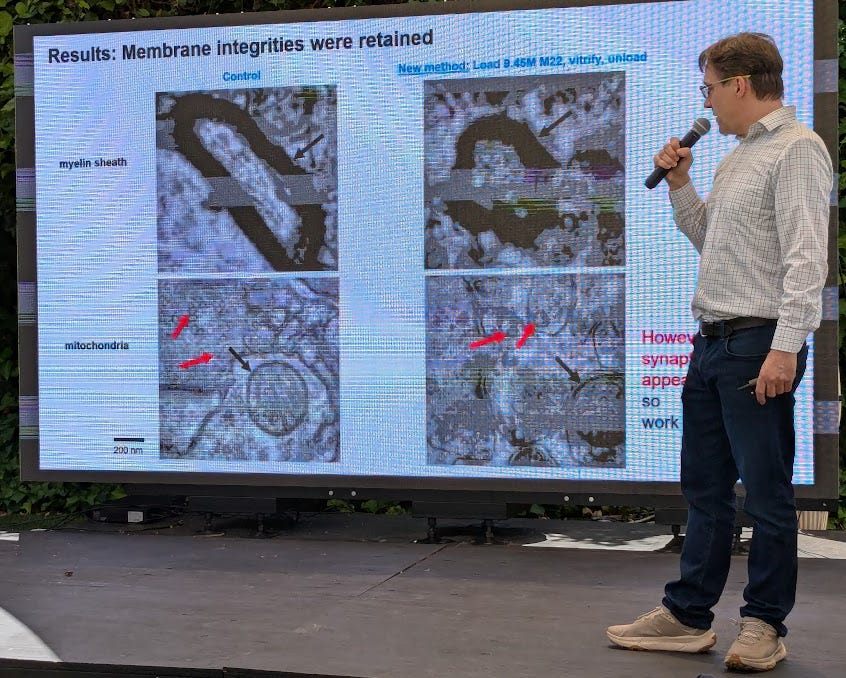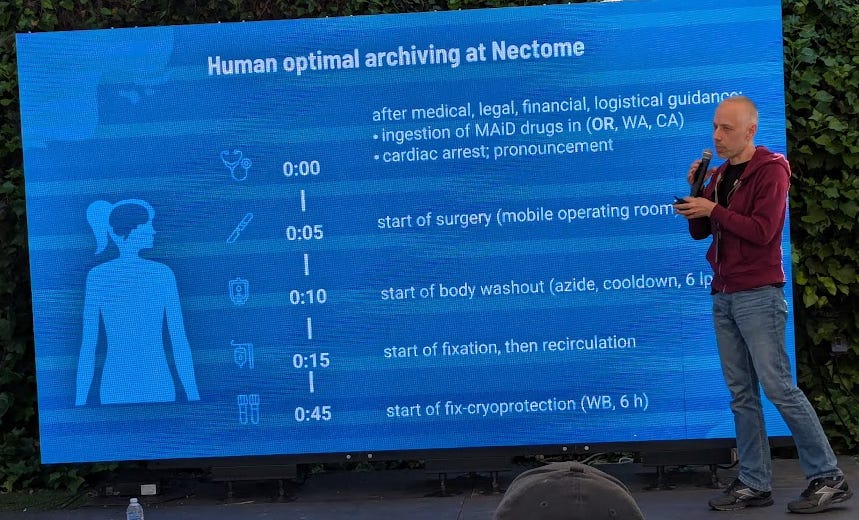I recently attended the Biostasis Week portion of Vitalist Bay, an eight-week longevity festival/conference being held in Berkeley, California. Adam Gries and Nathan Cheng, two of the main organisers of this ‘longevity zone’, have put together an extensive program of events and connected miniconferences in an effort to encourage the creation of “an Apollo-program-style step-change in the amount of effort and funding” dedicated to abolishing ageing and death.
While the other seven weeks mostly focused on promoting the development of anti-ageing medicine, Biostasis Week was dedicated to the insurance plan. Around 100 scientists, preservation providers, entrepreneurs, and general attendees gathered to share updates on the latest scientific developments and logistical considerations relevant to trying to pause death.
Some highlights1:
Emil Kendziorra of Tomorrow Biostasis, a human cryopreservation provider, shared CT images of the brains of some of the patients they have recently preserved. Unfortunately, despite success in vitrifying patient brains in an ice-free manner, this imaging data still shows considerable brain dehydration and shrinkage.
This issue with cryonics methodology has been previously described by the Brain Preservation Foundation. In comparison to living tissue or brains preserved with fixation-based techniques, the microscopic ‘ultrastructure’ of tissue samples taken from cryopreserved brains looks distorted and compressed. As a result, it is difficult to verify whether the neural connections that maintain someone’s memories remain intact within these shrunken brains, or whether they have been destroyed during the dehydration process.
To their credit, Emil stated that Tomorrow Biostasis has recently updated their consent forms to enable small brain biopsies to be taken from patients going forwards, so as to allow ultrastructural assessment in future cases. Specifically, he claimed that should the ultrastructure of these patients continue to look bad, even after they have tried some newer protocols they believe might mitigate the issue, then Tomorrow will have to pivot to different methods. I applaud this dedication to seeking out and acting on feedback.In contrast to the above, Ralf Spindler of 21st Century Medicine (21CM) claims to have made a recent breakthrough in cryopreserving brains without shrinkage.
Shrinkage occurs during the cryopreservation process due to the difficulty with cryoprotectants - which are needed to stop ice formation and enable vitrification - readily crossing the blood brain barrier. Because cryoprotectant concentrations are higher in the bloodstream than in brain tissue, this osmotic imbalance draws water from the brain and into the circulatory system.
But as of about four weeks ago, Ralf claims to have developed a method of vitrifying whole rodent brains without shrinkage or ultrastructure damage. Specifically, Ralf claims to have taken whole rodent brains, loaded them with 9.45M of the cryoprotectant M22, vitrified them, thawed them out, unloaded the cryoprotectant, sliced the brains for imaging, and then taken electron micrograph images showing uncompressed tissue, intact membranes and identifiable synapses.Should these claims bear out, 21CM may have developed a way to preserve brains in high quality without the need for fixatives. Ralf was coy about how exactly they’ve achieved this breakthrough (I assume blood brain barrier modifiers like SDS?), stating they would publish the results after further refinement of the technique and viability testing of tissue samples preserved this way. I eagerly await this data!
But don’t get too excited - Aschwin de Wolf of Advanced Neural Biosciences emphasised that even if reversible cryopreservation of a whole brain is achieved, that solves only one of many problems on the path to being able to revive an entire animal from a preserved state. Aschwin would know - his lab is currently working on attempting exactly this for a whole rat. While they’ve already been able to successfully revive a rat when cooled to just above 0°C, there are many difficulties when trying to go colder:
How to load and unload cryoprotectants from the brain while minimizing toxicity?
How to balance the fact that different organs have different ideal cryoprotectant properties?
Aschwin remains hopeful these problems can be overcome - he’s recently received a grant from CryoDAO to attempt it, at least - but cautions that success may be a long time coming still.
In the meantime, chemical fixation methods still provide the highest quality brain preservation available to terminally ill patients, according to Andrew McKenzie of Apex Neuroscience & Oregon Brain Preservation. Based in Salem, Oregon, Andrew’s organisation is currently offering free preservation to individuals located in Washington, Oregon, and Northern California - so long as they’re willing to allow two small biopsies to be taken. They are hoping to use these samples to address some remaining questions in the chemical preservation space, such as:
How quickly does brain ultrastructure decay following bloodflow cessation?
How do different pre-death medical conditions (e.g. prolonged organ failure) affect preservation quality?
Can immersing brains in fixative give adequate preservation quality, or must preservation be done via perfusion of the circulatory system?
Lastly, Borys Wrobel of Nectome is working on providing as-perfect-as-possible brain preservation. Specifically, for terminally ill patients considering medically-assisted dying, Nectome is planning to offer a preservation procedure with a delay of no more than fifteen minutes between blood flow cessation and fixative perfusion. The combination of assisted dying and an extremely fast procedure should greatly minimise ischemic damage (something Nectome plans to prove by collecting perfusion CT images and biopsies from patients, as well as in animal studies.)
Borys notes that they want to start providing services this year, and are currently raising a Seed-2 round with a goal of $3.5 million in order to do so. If you’re interested in investing, you can reach Borys at wrobel@eibr.eu.
Overall, it was great to see so many people interested in helping people have a chance of more time come together in one place! While there were sometimes somewhat heated discussions on both technical matters (what level of ultrastructure traceability is good enough?) and philosophical considerations (would an emulation be me, or just a copy? How scientific is traditional cryonics?), it was heartening to see so many people taking the prospect of preservation seriously.
As per the survey of neuroscientists that I presented at the conference - which showed that the typical neuroscientist believes there’s a 40% probability that a well-preserved brain retains its long-term memories and could eventually be uploaded (preprint, blog post, news article) - I strongly suspect that there’s more general sympathy for developing preservation into an accessible medical procedure than is currently acknowledged. It’s great to see the community grow.
Thanks to Adam and Nathan for putting Vitalist Bay together, and to Eric Magro, Rebecca Ziegler, Max Marty and Daniel Walters from the Cryosphere for organising Biostasis Week specifically. I’m looking forward to seeing all the progress that will be made by the time the next one comes around!
These are definitely biased towards the scientific content presented. There were also a bunch of talks about logistics, historical overviews of cryonics, community building, and the relationship between preservation and anti-ageing medicine.









Lovely article and summary by Ariel Z-J. I was originally planning to be at this event and speaking, but had a coincidental corporate trip which we earned over two years. (Which we also didn't go to since I had a bike fall and messed up my knee. )
Great summaries of these presentations, which seem very credible and compelling. I thought, indeed was informed very clearly, that Alcor CEO James Arrowwood was also going to present, but I didn't see a mention of Alcor at all. (?).
Next year at Vitalist Bay! (If they do this annually.)
The lack of microstructural/ultrastructural analysis from cryonics companies has been an issue for a while, and was part of the impetus for the Brain Preservation Prize. The traditional excuse has been that the tissue shrinks due to dehydration etc, and in the shruken state tracing the boundaries of cells on EM is nearly impossible. However, I believe they could rehydrate the tissue and image it, easily, but the cryonics companies have never shared such data. I'm glad to hear there is some movement towards greater transparency on the issue.